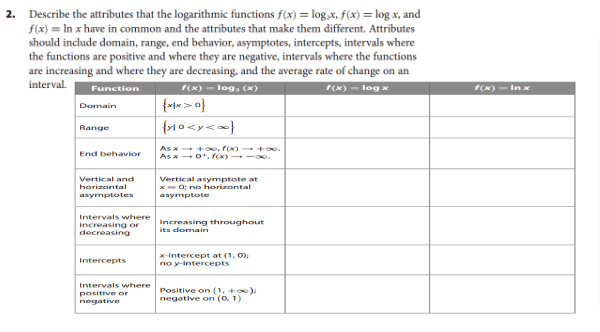that the logar log x, and f(x) = In x have in common and the attributes that make them different. Attributes should include domain, range, end behavior, asymptotes, intercepts, intervals where the functions are positive and where they are negative, intervals where the functions are increasing and where they are decreasing, and the average rate of change on an (H) - log x interval. Function (N)- log. (N) (N) - In x {ww>o} Domain Range {y1 0
that the logar log x, and f(x) = In x have in common and the attributes that make them different. Attributes should include domain, range, end behavior, asymptotes, intercepts, intervals where the functions are positive and where they are negative, intervals where the functions are increasing and where they are decreasing, and the average rate of change on an (H) - log x interval. Function (N)- log. (N) (N) - In x {ww>o} Domain Range {y1 0
Chapter6: Exponential And Logarithmic Functions
Section6.8: Fitting Exponential Models To Data
Problem 3TI: Table 6 shows the population, in thousands, of harbor seals in the Wadden Sea over the years 1997 to...
Related questions
Question
100%
Describe The Attributes that the logarithmic functions

Transcribed Image Text:2. Describe the attributes that the logarithmic functions f(x) = log,x, f(x) = log x, and
f(x) = In x have in common and the attributes that make them different. Attributes
should include domain, range, end behavior, asymptotes, intercepts, intervals where
the functions are positive and where they are negative, intervals where the functions
are increasing and where they are decreasing, and the average rate of change on an
interval.
(x) - log x
(N) - In x
Function
(x)
log, (x)
{> 아
Domain
{r1 0 <y<=}
Range
As x +0o, f() too.
As x 0+, fx) -o.
End behavior
Vertical and
horizontal
Vertical asymptote at
*- O; no horizontal
asymptote
asymptotes
Intervals where
Increasing throughout
its domain
Increasing or
decreasing
x-intercept at (1, 0);
no y-intercepts
Intercepts
Intervals where
positive or
negative
Positive on (1, +o)
negative on (0, 1)
Expert Solution
This question has been solved!
Explore an expertly crafted, step-by-step solution for a thorough understanding of key concepts.
This is a popular solution!
Trending now
This is a popular solution!
Step by step
Solved in 2 steps

Knowledge Booster
Learn more about
Need a deep-dive on the concept behind this application? Look no further. Learn more about this topic, algebra and related others by exploring similar questions and additional content below.Recommended textbooks for you


Algebra & Trigonometry with Analytic Geometry
Algebra
ISBN:
9781133382119
Author:
Swokowski
Publisher:
Cengage

College Algebra (MindTap Course List)
Algebra
ISBN:
9781305652231
Author:
R. David Gustafson, Jeff Hughes
Publisher:
Cengage Learning


Algebra & Trigonometry with Analytic Geometry
Algebra
ISBN:
9781133382119
Author:
Swokowski
Publisher:
Cengage

College Algebra (MindTap Course List)
Algebra
ISBN:
9781305652231
Author:
R. David Gustafson, Jeff Hughes
Publisher:
Cengage Learning

College Algebra
Algebra
ISBN:
9781305115545
Author:
James Stewart, Lothar Redlin, Saleem Watson
Publisher:
Cengage Learning